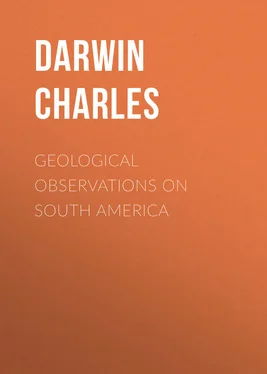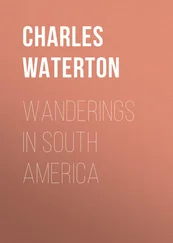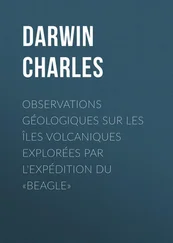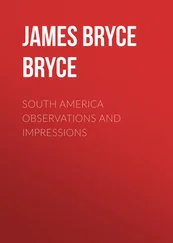Charles Darwin - Geological Observations on South America
Здесь есть возможность читать онлайн «Charles Darwin - Geological Observations on South America» — ознакомительный отрывок электронной книги совершенно бесплатно, а после прочтения отрывка купить полную версию. В некоторых случаях можно слушать аудио, скачать через торрент в формате fb2 и присутствует краткое содержание. Жанр: foreign_antique, foreign_prose, на английском языке. Описание произведения, (предисловие) а так же отзывы посетителей доступны на портале библиотеки ЛибКат.
- Название:Geological Observations on South America
- Автор:
- Жанр:
- Год:неизвестен
- ISBN:нет данных
- Рейтинг книги:3 / 5. Голосов: 1
-
Избранное:Добавить в избранное
- Отзывы:
-
Ваша оценка:
- 60
- 1
- 2
- 3
- 4
- 5
Geological Observations on South America: краткое содержание, описание и аннотация
Предлагаем к чтению аннотацию, описание, краткое содержание или предисловие (зависит от того, что написал сам автор книги «Geological Observations on South America»). Если вы не нашли необходимую информацию о книге — напишите в комментариях, мы постараемся отыскать её.
Geological Observations on South America — читать онлайн ознакомительный отрывок
Ниже представлен текст книги, разбитый по страницам. Система сохранения места последней прочитанной страницы, позволяет с удобством читать онлайн бесплатно книгу «Geological Observations on South America», без необходимости каждый раз заново искать на чём Вы остановились. Поставьте закладку, и сможете в любой момент перейти на страницу, на которой закончили чтение.
Интервал:
Закладка:
On the island of Quiriquina (in the Bay of Concepcion), I found, at an estimated height of four hundred feet, extensive layers of shells, mostly comminuted, but some perfectly preserved and closely packed in black vegetable mould; they consisted of Concholepas, Fissurella, Mytilus, Trochus, and Balanus. Some of these layers of shells rested on a thick bed of bright-red, dry, friable earth, capping the surface of the tertiary sandstone, and extending, as I observed whilst sailing along the coast, for 150 miles southward: at Valparaiso, we shall presently see that a similar red earthy mass, though quite like terrestrial mould, is really in chief part of recent marine origin. On the flanks of this island of Quiriquina, at a less height than the 400 feet, there were spaces several feet square, thickly strewed with fragments of similar shells. During a subsequent visit of the "Beagle" to Concepcion, Mr. Kent, the assistant-surgeon, was so kind as to make for me some measurements with the barometer: he found many marine remains along the shores of the whole bay, at a height of about twenty feet; and from the hill of Sentinella behind Talcahuano, at the height of 160 feet, he collected numerous shells, packed together close beneath the surface in black earth, consisting of two species of Mytilus, two of Crepidula, one of Concholepas, of Fissurella, Venus, Mactra, Turbo, Monoceros, and the Balanus psittacus. These shells were bleached, and within some of the Balani other Balani were growing, showing that they must have long lain dead in the sea. The above species I compared with living ones from the bay, and found them identical; but having since lost the specimens, I cannot give their names: this is of little importance, as Mr. Broderip has examined a similar collection, made during Captain Beechey's expedition, and ascertained that they consisted of ten recent species, associated with fragments of Echini, crabs, and Flustrae; some of these remains were estimated by Lieutenant Belcher to lie at the height of nearly a thousand feet above the level of the sea. ("Zoology of Captain Beechey's Voyage" page 162.) In some places round the bay, Mr. Kent observed that there were beds formed exclusively of the Mytilus Chiloensis: this species now lives in parts never uncovered by the tides. At considerable heights, Mr. Kent found only a few shells; but from the summit of one hill, 625 feet high, he brought me specimens of the Concholepas, Mytilus Chiloensis, and a Turbo. These shells were softer and more brittle than those from the height of 164 feet; and these latter had obviously a much more ancient appearance than the same species from the height of only twenty feet.
COAST NORTH OF CONCEPCION.
The first point examined was at the mouth of the Rapel (160 miles north of Concepcion and sixty miles south of Valparaiso), where I observed a few shells at the height of 100 feet, and some barnacles adhering to the rocks three or four feet above the highest tides: M. Gay found here recent shells at the distance of two leagues from the shore. ("Annales des Scienc. Nat." Avril 1833.) Inland there are some wide, gravel-capped plains, intersected by many broad, flat-bottomed valleys (now carrying insignificant streamlets), with their sides cut into successive wall-like escarpments, rising one above another, and in many places, according to M. Gay, worn into caves. The one cave (C. del Obispo) which I examined, resembled those formed on many sea-coasts, with its bottom filled with shingle. These inland plains, instead of sloping towards the coast, are inclined in an opposite direction towards the Cordillera, like the successively rising terraces on the inland or eastern side of Chiloe: some points of granite, which project through the plains near the coast, no doubt once formed a chain of outlying islands, on the inland shores of which the plains were accumulated. At Bucalemu, a few miles northward of the Rapel, I observed at the foot, and on the summit-edge of a plain, ten miles from the coast, many recent shells, mostly comminuted, but some perfect. There were, also, many at the bottom of the great valley of the Maypu. At San Antonio, shells are said to be collected and burnt for lime. At the bottom of a great ravine (Quebrada Onda, on the road to Casa Blanca), at the distance of several miles from the coast, I noticed a considerable bed, composed exclusively of Mesodesma donaciforme, Desh., lying on a bed of muddy sand: this shell now lives associated together in great numbers, on tidal-flats on the coast of Chile.
VALPARAISO.
During two successive years I carefully examined, part of the time in company with Mr. Alison, into all the facts connected with the recent elevation of this neighbourhood. In very many parts a beach of broken shells, about fourteen or fifteen feet above high-water mark, may be observed; and at this level the coast-rocks, where precipitous, are corroded in a band. At one spot, Mr. Alison, by removing some birds' dung, found at this same level barnacles adhering to the rocks. For several miles southward of the bay, almost every flat little headland, between the heights of 60 and 230 feet (measured by the barometer), is smoothly coated by a thick mass of comminuted shells, of the same species, and apparently in the same proportional numbers with those existing in the adjoining sea. The Concholepas is much the most abundant, and the best preserved shell; but I extracted perfectly preserved specimens of the Fissurella biradiata, a Trochus and Balanus (both well-known, but according to Mr. Sowerby yet unnamed) and parts of the Mytilus Chiloensis. Most of these shells, as well as an encrusting Nullipora, partially retain their colour; but they are brittle, and often stained red from the underlying brecciated mass of primary rocks; some are packed together, either in black or reddish moulds; some lie loose on the bare rocky surfaces. The total number of these shells is immense; they are less numerous, though still far from rare, up a height of 1,000 feet above the sea. On the summit of a hill, measured 557 feet, there was a small horizontal band of comminuted shells, of which MANY consisted (and likewise from lesser heights) of very young and small specimens of the still living Concholepas, Trochus, Patellae, Crepidulae, and of Mytilus Magellanicus (?) (Mr. Cuming informs me that he does not think this species identical with, though closely resembling, the true M. Magellanicus of the southern and eastern coast of South America; it lives abundantly on the coast of Chile.): several of these shells were under a quarter of an inch in their greatest diameter. My attention was called to this circumstance by a native fisherman, whom I took to look at these shell-beds; and he ridiculed the notion of such small shells having been brought up for food; nor could some of the species have adhered when alive to other larger shells. On another hill, some miles distant, and 648 feet high, I found shells of the Concholepas and Trochus, perfect, though very old, with fragments of Mytilus Chiloensis, all embedded in reddish-brown mould: I also found these same species, with fragments of an Echinus and of Balanus psittacus, on a hill 1,000 feet high. Above this height, shells became very rare, though on a hill 1,300 feet high (Measured by the barometer: the highest point in the range behind Valparaiso I found to be 1,626 feet above the level of the sea.), I collected the Concholepas, Trochus, Fissurella, and a Patella. At these greater heights the shells are almost invariably embedded in mould, and sometimes are exposed only by tearing up bushes. These shells obviously had a very much more ancient appearance than those from the lesser heights; the apices of the Trochi were often worn down; the little holes made by burrowing animals were greatly enlarged; and the Concholepas was often perforated quite through, owing to the inner plates of shell having scaled off.
Читать дальшеИнтервал:
Закладка:
Похожие книги на «Geological Observations on South America»
Представляем Вашему вниманию похожие книги на «Geological Observations on South America» списком для выбора. Мы отобрали схожую по названию и смыслу литературу в надежде предоставить читателям больше вариантов отыскать новые, интересные, ещё непрочитанные произведения.
Обсуждение, отзывы о книге «Geological Observations on South America» и просто собственные мнения читателей. Оставьте ваши комментарии, напишите, что Вы думаете о произведении, его смысле или главных героях. Укажите что конкретно понравилось, а что нет, и почему Вы так считаете.












